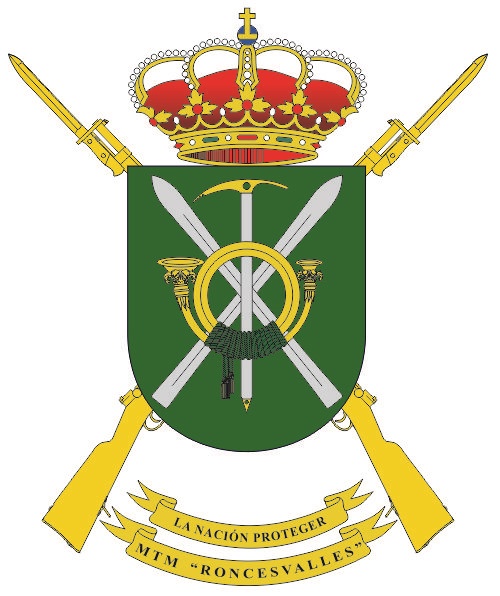MENÚ UNIDAD
ARMY UNITS
- Araba Álava |
- Albacete |
- Alicante |
- Almería |
- Asturias |
- Ávila |
- Badajoz |
- Barcelona |
- Burgos |
- Cáceres |
- Cádiz |
- Cantabria |
- Castellón |
- Ceuta |
- Ciudad Real |
- Córdoba |
- A Coruña |
- Cuenca |
- Girona |
- Granada |
- Guadalajara |
- Gipuzkoa |
- Huelva |
- Huesca |
- Islas Baleares |
- Jaén |
- León |
- Lleida |
- Lugo |
- Madrid |
- Málaga |
- Melilla |
- Murcia |
- Navarra |
- Ourense |
- Palencia |
- Las Palmas |
- Pontevedra |
- La Rioja |
- Salamanca |
- Segovia |
- Sevilla |
- Soria |
- Tarragona |
- Santa Cruz de Tenerife |
- Teruel |
- Toledo |
- Valencia |
- Valladolid |
- Bizkaia |
- Zamora |
- Zaragoza

Background
- pagination
-
The "Roncesvalles" Mountain Troops Command, which is part of the San Marcial Division, is prepared and specialized to act on extremely difficult terrain and in adverse weather conditions. It is versatile and equipped with materiel that enables it to act not only in the mountains but in any national or international geographical scenario and in all those operations in which its units are required. With a high degree of readiness, it has always demanded from its members a great capacity for sacrifice and high preparedness, both technical, physical and mental. It is the heir to and is imbued with the mountain spirit of our mountain units.
In Spain, the descriptor "Mountain" for certain units began to be used late in our history, perhaps because there was no need to make this distinction with the first units of foot soldiers, who were equipped with basic weapons and beasts of burden, and were used on any terrain. However, the units that had to fight in the mountains were usually comprised of local people, who knew the terrain and were accustomed to traveling in it, ensuring greater combat capacity in this environment. At first, these units were not assigned the label "Mountain".
The units of "Chasseurs" began their journey in the infantry of 1847, as complete units of battalion size. It would not be until 1899 that mountain units were created on the basis of some of these units. Both terms coexisted until 1904, when the name "Mountain" temporarily disappeared from these units. In 1918, it appeared again with the name "Mountain Chasseurs" to distinguish them from units that went under the name "Chasseurs". We could associate the term Chasseurs with Light Infantry, but capable of fighting in the mountains, while the name "Mountain" was reserved for units specially trained to act in this environment. In 1925, the "Mountain Chasseurs" units were renamed "Mountain", and kept this name until the Spanish Civil War.
The first record of the Mountain Troops Command, as a Large Unit, dates from February 1st, 1966 when the High Mountain Brigade (BRIAM) was constituted, according to the provisions of General Instruction 165/142 of the Central Staff, contributing in this manner to maintaining the spirit and preserving the traditions of the mountain units that went back to the old Mountain Chasseurs Groups of the 51st and 52nd Divisions. Twenty years later, in 1986, it was renamed the 42nd High Mountain Chasseurs Brigade, remaining part of the 4th Mountain Division “Urgel”. On July 1st, 1996, and as a consequence of the application of Plan Norte, the Brigade changed its name again, becoming the 1st Mountain Chasseurs Brigade “Aragón”, remaining part of the Army’s Maneuver Force. Since the mid-1990s, the 1st BRCZM “Aragón” has been assigned to NATO's high-availability forces, as well as to other multinational headquarters, actively participating in exercises carried out each year in member countries of the Alliance. The last ones were carried out in France, Greece, Italy, Norway, the United Kingdom and Turkey. Likewise, more than 5,000 service personnel from these units actively participated in the various peacekeeping operations abroad in Bosnia, Albania, Kosovo and Afghanistan.
Other relevant actions and missions carried out by the Brigade were Operation Alazán from March 1980 to July 1982, the Universities of Jaca in 1981 and 1995, the Olympic Games of Barcelona in 1992, the tragedy of Camping Las Nieves in August 1996, the catastrophe of the Prestige in 2004, the protection of the AVE (High-Speed Rail) train in 2004-2005 or the EYOF 2007.
Under the provisions of General Standard 05/07 on Organizational Adjustments of the Army for 2007, as of January 1st, 2008, the 1st BRCZM was renamed Aragón Mountain Troops Head Office.
As of January 1st, 2017 and in compliance with the communicated Resolution No. 02/2015 and General Standard 03/15, the Regiments belonging to the Headquarters began reporting to the 12th Brigades "Guadarrama" and "Aragón".
Order DEF/708/2020, which develops the basic organization of the Army, created a new Mountain Troops Command in the San Marcial Division, defined as "a group of units under a single command, organized, equipped and trained to provide the capacity for life, movement and combat in mountains and cold weather in those operations requiring such capacities.”
Coat of Arms
HERALDIC DESCRIPTION:
On a field Sinople (green), two skis passant Argent (silver) in cross, over all an ice ax Or (gold) in pale, the handle coated with silver, and a chasseur’s bugle Or (gold) bundled in Sinople (green).JUSTIFICATION:
The skis and ice ax represent the specificity of the Unit. The background of the field and the chasseur's bugle are traditional symbols of the Mountain units.MOTTO:
To protect the Homeland.Himno de las Tropas de Montaña



